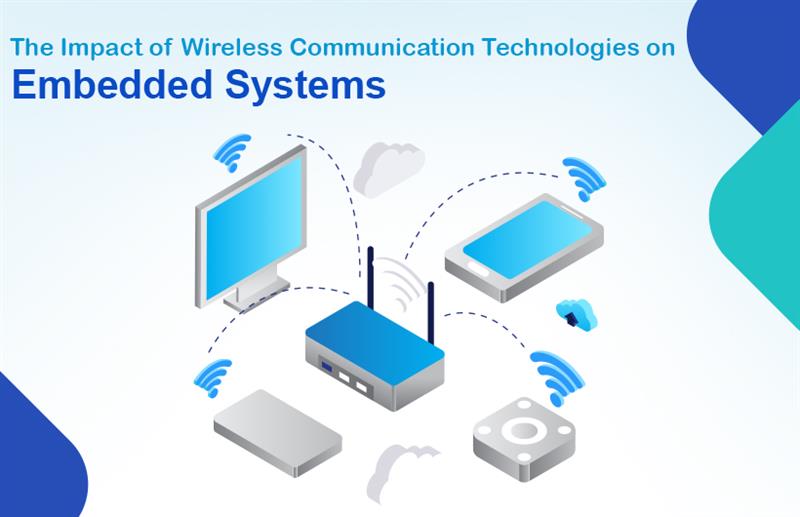Wireless communication technologies have revolutionized the way embedded systems operate across various industries. From consumer electronics to industrial automation, wireless communication enables seamless connectivity, real-time data exchange, and enhanced functionality. With the rapid evolution of IoT (Internet of Things) and smart devices, wireless embedded systems have leveraged wireless technologies to improve efficiency, reduce costs, and enhance user experience. This blog explores the impact of wireless communication technologies on embedded systems, their advantages, challenges, and future trends.
Understanding Wireless Communication in Embedded Systems
Embedded systems are dedicated computing devices designed for specific functions within larger systems. They operate with limited resources, making efficient communication critical. Wireless communication technologies enable embedded systems to transmit data without physical connections, reducing wiring complications and allowing greater flexibility in system design. Common wireless communication protocols used include:
1. Wi-Fi (IEEE 802.11) – Provides high-speed wireless connectivity for embedded devices, commonly used in smart homes, industrial automation, and healthcare applications.
2. Bluetooth (IEEE 802.15.1) – Enables short-range communication between devices, widely used in consumer electronics and wearable technology.
3. Zigbee (IEEE 802.15.4) – A low-power communication protocol used in IoT applications, smart grids, and home automation.
4. LoRa (Long Range) – Ideal for long-range, low-power applications such as agricultural monitoring and industrial IoT.
5. NB-IoT (Narrowband IoT) and LTE-M – Cellular-based wireless technologies designed for low-power, wide-area network (LPWAN) applications.
6. 5G – The latest advancement in communication, offering ultra-fast, low-latency connectivity for embedded systems in automotive, healthcare, and smart city applications.
Advantages of Wireless Communication in Embedded Systems
The integration of wireless communication technologies in embedded systems offers several benefits, including:
1. Enhanced Connectivity and Remote Access
Wireless technologies allow embedded systems to communicate over long distances, enabling real-time monitoring, control, and remote features. This is particularly useful in industrial automation, healthcare, and smart city applications.
2. Reduced Infrastructure and Wiring Costs
Traditional wired communication requires extensive cabling, which adds to installation and maintenance costs. Wireless communication removes these expenses, making it more cost-effective and easier to deploy in challenging environments.
3. Energy Efficiency and Low Power Consumption
Wireless protocols such as Zigbee, LoRa, and NB-IoT are designed for low-power operation, extending battery life in embedded devices. This makes them ideal for IoT applications where devices operate in remote locations with limited power sources.
4. Scalability and Flexibility
Wireless communication allows embedded systems to scale effortlessly, supporting the addition of new devices without significant hardware modifications. This flexibility is crucial for growing IoT networks and expanding industrial applications.
5. Improved Data Collection and Analysis
Embedded systems with wireless ability can collect, transmit, and analyze data in real time, enabling predictive maintenance, better decision-making, and automation in various industries.
Challenges of Wireless Communication in Embedded Systems
Despite the numerous advantages, integrating wireless communication into embedded systems also presents some challenges:
1. Security Concerns
Wireless communication is susceptible to cyber threats such as hacking, data breaches, and unauthorized access. Applying strong encryption, authentication, and secure communication protocols is essential to mitigate these risks.
2. Interference and Reliability Issues
Wireless networks operate in shared frequency bands, which can cause interference from other devices. Factors such as physical obstacles, signal degradation, and environmental conditions can impact reliability and data transmission quality.
3. Latency and Bandwidth Limitations
Certain applications require low-latency and high-bandwidth communication, which may not be feasible with some wireless protocols. Choosing the right communication technology based on application requirements is crucial for performance optimization.
4. Regulatory Compliance
Different countries have specific regulations regarding wireless frequency usage and power levels. Ensuring compliance with these regulations is essential to avoid legal and operational issues.
5. Power Management
Although many wireless communication protocols focus on energy efficiency, managing power consumption remains a challenge in battery-operated devices. Advanced power management techniques and energy harvesting solutions can help address this issue.
Future Trends in Wireless Communication for Embedded Systems
As technology continues to evolve, the future of wireless communication is promising. Key trends shaping the industry include:
1. 5G and Beyond
The deployment of 5G networks will significantly enhance the capabilities of embedded systems, enabling ultra-fast data transfer, low latency, and improved network reliability. This will drive advancements in autonomous vehicles, smart factories, and healthcare monitoring systems.
2. Edge Computing and AI Integration
Wireless embedded systems are increasingly abusing edge computing and artificial intelligence (AI) to process data locally, reducing latency and bandwidth consumption. This is particularly beneficial for real-time applications in industrial automation and smart infrastructure.
3. Ultra-Low Power Wireless Technologies
Innovations in ultra-low power wireless communication, such as Bluetooth Low Energy (BLE) and next-generation LPWAN protocols, will further extend battery life in IoT devices, making them more sustainable and efficient.
4. Mesh Networking for IoT Expansion
Mesh networking, where devices communicate with each other without relying on a central hub, is gaining popularity. Zigbee, Thread, and Wi-Fi mesh networks will enhance the scalability and flexibility of IoT ecosystems.
5. Increased Focus on Security and Privacy
With the rise of wireless-enabled embedded systems, cybersecurity measures such as end-to-end encryption, secure boot mechanisms, and AI-driven threat detection will become more critical in preventing data breaches and ensuring system integrity.
Conclusion
Wireless communication technologies have transformed embedded systems, enabling enhanced connectivity, cost efficiency, and scalability across various industries. While challenges such as security, interference, and power management persist, advancements in 5G, edge computing, and AI pave the way for a smarter, more connected future. As technologies continue to evolve, embedded systems will play a crucial role in driving innovation in IoT, industrial automation, healthcare, and beyond. Companies like Monarch Innovation are at the forefront of integrating these technologies to develop cutting-edge embedded solutions that meet the demands of the modern digital era.





